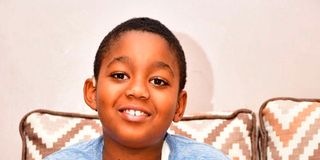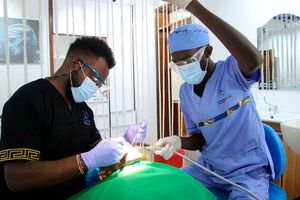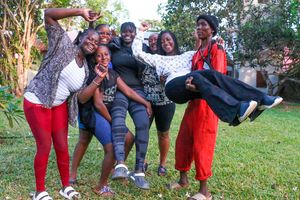Breaking News: Former Lugari MP Cyrus Jirongo dies in a road crash
Baby Amari was born deaf. Now he hears and speaks
What you need to know:
- Kenya has about 153,381 people who are deaf, according to the 2019 Kenya Population and Housing Census report. The report further shows that most deaf people (129,518) are in rural areas compared to urban areas (23,843).
- Each year, almost 3,000 children in Kenya are born deaf. If the screening is not done at birth, they will end up missing out on the currently available interventions for them, courtesy of technology.
When Amari Karongo was born 10 years ago, his mother, Catherine Wanjiku Wachira, welcomed a healthy baby weighing 3.9 kilogrammes.
The family lived in Utawala, Nairobi in a building still under construction on the upper floors. There was always a concrete mixer running during the day, but even with the noise, Amari would sleep peacefully.
“I thought my son was a deep sleeper because when I got home from work, my house help would tell me that he had been sleeping the whole afternoon without being bothered by the concrete mixer on the upper floor of our house,” says Catherine.
When with friends, Catherine would hear stories of how other children Amari’s age would respond when their parents opened doors in the evening while returning from work, but for her, her son was in his world.
“I used to hear stories of other mums saying ‘when I come back from work my baby starts crying when I am at the door’. However, I never heard that from my son. He wouldn’t cry when I was knocking on the door. And I never thought about it much but looking back, that was a sign that something was wrong,”
At nine months, Amari’s mother bought him a rattle, which she knew would excite him, but to her surprise, he held it, looked at it, and threw it away.
“I expected him to be excited and shake it because of the sounds. That was the confirmation that something was wrong,” narrates Catherine.
She took her son to a paediatrician and told the doctor she suspected the child was autistic.
“Why would I think my child was deaf? The concept of someone being born deaf had not occurred to me yet. I had associated deafness with old age,” she says.
Since she said her son was autistic, Catherine was sent to see a neurologist who did some tests and found nothing. The neurologist then recommended the child to see an audiologist for a hearing test.
According to Dr Shailendra Inamdar, a consultant ENT (ear, nose and throat ) surgeon at MP Shah Hospital, a baby’s hearing test takes just a few minutes.
“A small soft-tipped earpiece is placed in the baby’s ear and gentle clicking sounds are played. It’s not always possible to get clear responses from the first test. This happens with lots of babies and it does not always mean that the baby has permanent hearing loss,” the doctor explains.
It was then that Amari was confirmed to have severe-to-profound sensorineural hearing loss.
A person is said to have hearing loss if their hearing capacity is reduced and they are not able to hear as well as someone with normal hearing.
Normal hearing, according to the World Health Organization (WHO), refers to hearing thresholds of 20dB or better in both ears. Decibel (dB) is a unit for expressing the ratio between two physical quantities, usually amounts of acoustic or electric power, or for measuring the relative loudness of sounds.
Those with a hearing threshold above 20dB may be considered “hard of hearing” or “deaf,” depending upon the severity of their hearing loss.
The term “hard of hearing” is used to describe people with mild to severe hearing loss as they cannot hear as well as those with normal hearing. The term deaf describes the condition of people with severe or profound hearing loss in both ears who can hear only very loud sounds or hear nothing at all.
WHO says more than 1.5 billion people suffer hearing loss globally. The health body categorises hearing loss as mild, moderate, moderately-severe, severe, profound or complete.
The news that Amari was deaf came as a shocker to Catherine, and she sought second and third opinions from other specialists.
With the confirmation of Amari’s hearing loss, specialists recommended hearing aids.
According to Dr Inamdar, hearing aids consist of a microphone, amplifier and receiver. The microphone picks up the sounds around the wearer and converts them into electrical signals, which are then processed and amplified. The electrical signals are converted back to sound and the receiver sends the amplified sounds into the ear through the earmould.
“An audiologist will programme the hearing aids to match a child’s deafness before testing them in the child’s ear to make sure that the signal (or frequency response) coming from the hearing aid matches as closely as possible.”
Dr Inamdar further explains that a cochlear implant differs from a hearing aid.
“Hearing aids amplify sounds so damaged ears may detect them. However, Cochlear implants bypass damaged portions of the ear and directly stimulate the auditory nerve.” Signals generated by the implant are sent by way of the auditory nerve to the brain, which recognises the signals as sound. Hearing through a cochlear implant differs from normal hearing and takes time to learn or relearn.
But it allows many people to recognise warning signals, understand other sounds in the environment, and understand speech in person or over the telephone. This was the first time Catherine was coming across a deaf person. She had zero knowledge of this matter and thus decided to make Google her friend.
During her research, she discovered how unaffordable cochlear implants are. Her medical insurance would only cater for Sh600,000 since it’s an assistive device, and at the time the device cost Sh3.5 million.

Catherine Wanjiku (right) reads a book to her son Amari Karongo at their home in Kasarani, Nairobi on February 18, 2023.
“I could not believe that the intervention I needed for my son would cost me millions of shillings. That was the beginning of me understanding the structural injustice of disability,” she notes.
With a figure in her head, Catherine returned to her family to fundraise and by the time she was done with the fundraiser, Amari was four years old. The information she got later was that early intervention is critical to successful rehabilitation outcomes in people with hearing loss as delays harm language development, communication, social well-being and cognition.
“We raised a good amount but it was not enough. I went to Google again and found a website called Alexander Graham Bell foundation and under financial aid they have a long list of organisations that help children and people who are deaf,” she adds.
Catherine would go through each link, read the eligibility criteria and if her son qualified, she would email them. That is how she eventually found a foundation that helped her son.
“They only wanted us to cater for flight and accommodation and they would cater for the device (cochlear implant) and since we had fundraised, we were ready with that money. We found ourselves in Texas, US, got the device, stayed there for some months of rehabilitation then came back home.”
Work on his speech
After getting the cochlear implant, Catherine and her family embarked on a journey to work on Amari’s speech.
It was after the fitting of the cochlear that Catherine realised why the specialists insisted on her finding the solution for her son as soon as possible.
“They say that the moment you are fitted with a hearing device, the hearing is like for a newborn. Even though Amari was four years, we were now starting from zero with his hearing. So, we were teaching him how to respond to his name when called.”
To help him with his hearing, Amari was introduced to Auditory verbal therapy (AVT).
AVT is a highly specialised early intervention family-centred coaching programme that provides parents and caretakers with the tools to promote the development of their deaf child’s speech and language, according to Edith Mbaya, an Auditory Verbal Teacher.
Edith says through play-based therapy sessions; parents are given the tools – Auditory Verbal techniques and strategies – to develop their child’s listening and spoken language.
After starting the session, Catherine noticed she also needed to be a ‘mini therapist.’
“You do not take the child to the therapy and leave and let them do it. Here, the therapist has to train the parents and family members to be a mini therapist at home since you have to learn how to develop a language-reach. We must know how to talk to him and thus you become a therapist.
Children’s development of spoken language is directly related to their hearing ability. Most studies on hearing loss show that delayed speech and language development in children is likely to continue into adulthood.

Amari Karongo, 10, during the interview at their home in Kasarani, Nairobi .
It took Amari about one year to say a single word. “It was a lot of him bubbling and repeating after what I was saying without it being meaningful. You know language is when you are communicating meaningful idea. If I say something in French right now and ask you to repeat, you can repeat but you won’t know what I meant. So he was at a place he could express his own idea and understand what I was saying and act upon it if required.”
Amari has delays in his speech since he took a long time to get intervention.
According to Edith, early intervention is critical to successful rehabilitation outcomes in people with hearing loss as delays harm language development, communication, social well-being, and cognition.
When Amari was ripe for school, getting one to accommodate him was challenging. “We needed a school where teachers were accommodating, where they would go through concepts he did not understand. This meant a school with fewer children was a bit expensive,” says Catherine.
There was also the stigma. “The moment you tell someone your child has a challenge and they ask you which one and you say deaf, they first tell you that they do not do sign language. So it becomes so tiring to have to explain and say he’s deaf, but he uses a device that helps him hear. But since he got it late, he has speech delay. People are not aware of these things and you cannot blame them because initially I too was not aware of all this.
“We eventually got a school. We continued doing the therapies at home after which he would practice at school.”
Catherine knew even though Amari got interventions to help him hear he was still deaf. She wanted him to associate with deaf people, so she started reading about the deaf culture.
Then she learnt sign language.
Today, Amari can sign and speak.
“Because my son started late, I need to use all the interventions possible to expose him to many forms of communication as possible. So that he can be able to express himself and share his ideas because that is the goal,” says Catherine.
Deaf culture is a unique community of individuals who are deaf or hard of hearing. They share a common language, values, beliefs, and norms distinct from other cultures. This culture is often referred to as a “Deaf world” or “Deafhood” and comprises people from all walks of life.
Deaf culture is based on sign language, a visual-gestural language that uses hand shapes, facial expressions, and body movements to communicate. It is also characterised by its traditions, art, literature, and humour as well as its social activities and organisations.
The culture is crucial because it helps to create a sense of belonging and community for deaf people. It also gives them a way to express themselves and their identity uniquely and uniquely.
According to a report released by WHO in 2021 dubbed The World Report On Hearing Unaddressed, hearing loss, including congenital hearing loss, constitutes a serious obstacle to a child’s development, education, and social integration. The impact of unaddressed hearing loss extends beyond adverse speech and language outcomes, especially in low- and middle countries.
A key mitigating factor is the age at which intervention (amplification or enrolment in educational programmes) is initiated. A significant body of research demonstrates that children whose hearing loss is identified at an early stage and who receive early intervention have better outcomes than those with later detection and treatment.
According to WHO, early intervention is critical to successful rehabilitation outcomes in people with hearing loss as delays harm language development, communication, social well-being and cognition.
Since hearing loss is invisible, it commonly remains undetected in children and adults. For this reason, extraordinary measures must be put in place to screen for hearing loss at different stages across the life course, says the agency.
Those most likely at risk of hearing loss include newborns and infants; children, especially in pre-school and school settings; older people and those exposed to noise, ototoxic chemicals and other medicines.
Kenya has about 153,381 people who are deaf, according to the 2019 Kenya Population and Housing Census report. The report further shows that most deaf people (129,518) are in rural areas compared to urban areas (23,843).
According to Dr Inamdar, each year, almost 3,000 children in Kenya are born deaf. If the screening is not done at birth, they will end up missing out on the currently available interventions for them, courtesy of technology.





